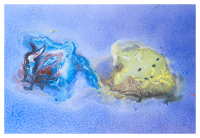Conveners
Parallel III: C4 Heavy Quarks: Decays and Lattice Results
- Pavel Pakhlov (ITEP)
Prof.
Ronald Horgan
(DAMTP, University of Cambridge)
11/09/2014, 16:30
Section C: Heavy Quarks
I report on progress by the HPQCD Collaboration using radiatively-improved lattice NonRelativistic QCD on ensembles of gluon field configurations that now include u, d, s and c quarks in the sea with the u/d quark mass going down to its physical value. I describe the background field approach for determining the one-loop radiative improvement to coefficients in the NRQCD action, and I present...
Taichi Kawanai
(RIKEN)
11/09/2014, 16:55
Section C: Heavy Quarks
We present quark-antiquark potentials for the charmonium, that are calculated using a relativistic heavy quark action for charm quarks and PACS-CS Iwasaki gauge configurations with 2 + 1 flavors of dynamical clover light quarks. The light quark masses are almost physical (pion mass ~ 156(7) MeV). The interquark potential with finite quark masses are defined through the equal-time...
Rudolf Faustov
(RAS)
11/09/2014, 17:15
Section C: Heavy Quarks
The branching fractions of the semileptonic and rare $B_s$ decays are calculated in the
framework of the QCD-motivated relativistic quark model. The form factors of the weak $B_s$ transitions are expressed through the overlap integrals of the initial and final meson wave functions in the whole accessible kinematical range. The momentum
transfer dependence of the form factors is explicitly...
Dmitri Melikhov
(SINP, M.V.Lomonosov Moscow State University)
11/09/2014, 17:35
Section C: Heavy Quarks
We present the analysis of the decay constants of charmed and beauty heavy mesons using QCD sum rules. We show that the perturbative expansion in terms of the pole mass of the heavy quark exhibits no sign of convergence whereas reorganizing this expansion in terms of the running mass leads to a distinct hierarchy. Making use of the OPE in terms of the running mass, we determine the decay...
Prof.
Francisco Fernandez
(Universidad de Salamanca)
11/09/2014, 17:55
Section C: Heavy Quarks
The hadronic transitions of heavy quarkonia such as $\psi
(nS)$ or $\Upsilon(nS)$ to lower states with emission of two pions are important tools for
understanding both, the heavy quarkonium dynamics and the formation of light hadrons.
The typical momentum involve in the transition is too low for perturbative QCD and then perturbative method does not apply.
The recent experimental data...
